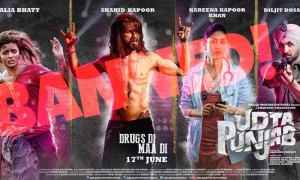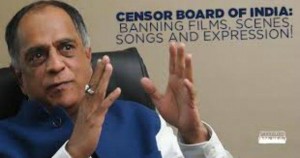In this blog post, Disha Pareek, a student of Rajiv Gandhi National University of Law, Punjab, writes about the powers of the Central Board of Film Certification (CBFC). The post discusses the related Act and the role of Indian judiciary and the future of CBFC.
It is nothing but an irony that the Central Board of Film Certification (CBFC), which is a statutory body (one created by an Act of Parliament or state Legislature) under Ministry of Information and Broadcasting, a body that certifies a film, is known by the name of Censor Board in general parlance. Now, there is a great difference between ‘certification’ and ‘censorship’.
The former is a process by which a film’s content is classified with reference to certain parameters, such as the age of the viewer, its sexual orientation, and violent content, moral or ethical implications and so on. It is more like an additional piece of information informing an audience to the content of a film in advance. However, even after the change in its name from Central Board of Film Censorship to Certification in the year 1986, it still indulges in censorship in the classical sense.
Tracing the origin
All movies are regulated so that they are suited for the purpose of public exhibition under the provisions of the Cinematograph Act, 1952. When the first Indian film (Raja Harishchandra) was produced in 1913, the Indian Cinematograph Act had not been enacted. It came into force only in the year 1920 and was placed under police chiefs in 5 cities. But, later in the year 1952, a board was reconstituted and got united.[1] Cinematograph (Certification) Rules were revised in the year 1983 and since then, the Central Board of Film Censors came to be known as the Central Board of Film Certification or CBFC.[2]
The Cinematograph Act, 1952
- The board, known as CBFC, is constituted by the Central Government in accordance with Section 3 of the said Act, consisting of a chairman and 10-25 other members as appointed by the Central Government.
- Under section 5-A, certification is done for films for which an application is given for the examination of the movie for its exhibition.[3]
These 4 certificates are given to the movies (any one)-
| “U”: Unrestricted Public exhibition | “UA”: unrestricted public exhibition, but requiring parental discretion needed for children below 12 years |
| “A” : Restricted to adults | “S” : restricted to any special class of persons[4] |
Powers of CBFC: A reality check (use or abuse)
The fight against the arbitrariness of CBFC can be traced back to year 1970, in the case of K. A. Abbas v. Union of India[5], a case concerning many unreasonable cuts in a movie “A Tale of 4 Cities” depicting the reality of India and difference in lives of rich and the poor. The producer approached the Supreme Court but could not succeed in his case.
The recent controversy of the much talked-about movie Udta Punjab, which deals with drug menace and its impact in Punjab, is somewhat similar, in the sense that Central Board of Film Certification (CBFC) asked for 94 unreasonable cuts in the movie. The movie got impetus regarding the constant fight between filmmakers and the board and became popular in the public domain. It’s been more than 40 years since the controversy of the movie Tale of 4 Cities erupted, but the position in India is still the same.
The question arises; is there Fundamental Right of Freedom of Speech and Expression available in a censored democracy like ours?
Although, Motion Pictures cannot be considered as medium of Free Speech and Expression but many court decisions shows that it has somewhat become so. Just because there is a threat of law and order problem attached with a movie, it cannot be banned or censored. India, being a country promoting unity in diversity, is moving ahead and leaving behind the orthodoxy and stereotypical thoughts. It must be the duty of law makers or the government to tackle such problems because censoring something would not help.
Pahlaj Nihalani: The man of scissors
Mr. Nihalani has been the butt of controversies since the day he stepped in as the Chief of the CBFC. He has even been compared with a grandmother and the dictator of North Korea. Even the appointment of Nihalani to this post is said to be through political lobbying.
- Then-CBFC chief Leela Sampson along with 9 other members resigned after there was interference, coercion and corruption involved. Mr Nihalani was appointed thereafter.
- After a few months of his appointment, the board was left red-faced when it came out with a list of banned words including the word “Bombay” and was mocked by social media.[6]
- Nihalani also targeted and criticised Sharmila Tagore for clearing the movie Omkara which was released in 2006.
- Gone are the days, when intimate scenes were considered obscene. But even after so many years, nothing stopped Mr Nihalani from trimming down a kissing scene from a James Bond movie, as a part of ‘Sanskar’.
- Movies are the most stirring medium for depicting a social cause, and it can leave a strong message for society to ponder upon. For instance, the issue of reservation, women empowerment, corruption and even rights of LGBT.
But, to everybody’s dismay, Raj Amit Kumar’s movie on LGBT “Unfreedom” was stopped from releasing.
Role of judiciary
Indian Judiciary has been playing a crucial role in this regard.
- The Supreme Court in Rangarajan v. P. Jagjivan Ram[7] overruled the decision of Madras High Court revoking a U certificate issued to a Tamil film called ‘Ore Oru Gramathile’
- A panel had been constituted under the chairmanship of judicial expert Mukul Mudgal, in February 2013 to review the functioning of the CBFC (Censor Board of Film Certification). Leela Samson (then CBFC Chief), Sharmila Tagore and Javed Akhtar were some of the important members of that committee.[8]
- A big win to not only the filmmakers of Udta Punjab, but the entire film industry was in June 2016 when the Bombay High Court (now referred as Mumbai HC) gave a prominent judgement and set precedents for the Indian Judiciary to follow. As against nearly 100 cuts prescribed by CBFC, it cleared ‘Udta Punjab’ with just one cut and set a precedent. The court opined that “CBFC is a body to certify films and not censor it.”
- The Honourable Bombay High Court has been fighting for this cause for a long time. Also in the case of release of the movie “Deshdrohi” by Kamaal Khan, which depicted the violence in state of Maharashtra; the court cleared the screening of the movie.[9]
- The Supreme Court of India, which is in a pivotal position, also did not meddle in the decisions of the High Court of Bombay (Mumbai) both at the time of screening of Deshdrohi[10] and Udta Punjab.
- Since there is no separate censorship for television, a case came to the Supreme Court against the judgment passed by Mumbai High Court in the case of Ramesh v. Union of India[11] petition demanding restrain for the screening of serial ‘Tamas’ as violative of Section 5 B of the 1952 Act.
- It is important to note that in the case of Union of India v K.M. Shankarappa, the Supreme Court disapproved of the Government retaining powers by enacting Section 6(1) of the 1952 Act and declared it ultra vires to the Constitution.
Conclusion
The future prospects would firstly include the government’s decision of setting up of ‘revamp committee’ headed by Shyam Benegal, an acclaimed filmmaker to look at future prospectives for the CBFC and make recommendations for proper overhauling of the system.
Apart from it, censoring movies in the name of maintaining public peace, respecting emotions of people and similar reasons are not valid, the viewers should have the right to watch the movie and form opinion on a subjective basis. The head of any organisation can bring many changes in it, so it is crucial that the chief of the CBFC should not be appointed on a political motivation and lobbying.
Freedom to Speech and Expression should also be seen in the light of an expansive interpretation and not in a narrow sense. They should also be provided with independence and autonomy so that they do not become puppets in the hands of government. The permanent solution would be an overhaul of the present archaic laws of 1952, which do not suit the present. An emphasis can be put to the decisions of High Courts and the Supreme Court in this regard.
Footnotes:
[1] Preetha Kadhir, Film Censorship: How does it work, The Hindu, February 4, 2013.
[2] Someshwar Bhownik, CBFC members have little knowledge of History of Cinema, Deccan Herald, 7 July, 2016
[3] Section 5-A of Cinematograph Act, 1952
[4] Available at “cbfcindia.gov.in/html/uniquepage.aspx?unique_page_id=6”
[5] 1971 AIR 481
[6] Who muted Bombay, Opindia, February 2, 2015, available at, “http://www.opindia.com/2015/02/who-muted-bombay-leela-samson-or-pahlaj-nihalani/”
[7] S. Rangarajan v. P. Jagjivan Ram, (1989) 2 S.C.C. 574, 592
[8] Available at “www.thehindu.com/news/national/mudgal-panel-submits-report-on-governing-cinema/article5218032.ece”
[9] Fears of MNS backlash prompted ‘Deshdrohi’ ban, EXPRESSINDIA.COM, Nov. 13, 2008, http://www.expressindia.com/latest-news/Fears-of-MNS-backlash-prompted-Deshdrohi-ban/385263/
[10] SC rejects Maharashtra plea, clears Deshdrohi, THE INDIAN EXPRESS, Jan. 24, 2009, available at http://www.indianexpress.com/news/sc-rejects-maharashtra-plea-clears-deshdrohi/414640/.
[11] 1988 AIR 775
 Serato DJ Crack 2025Serato DJ PRO Crack
Serato DJ Crack 2025Serato DJ PRO Crack














 Allow notifications
Allow notifications



